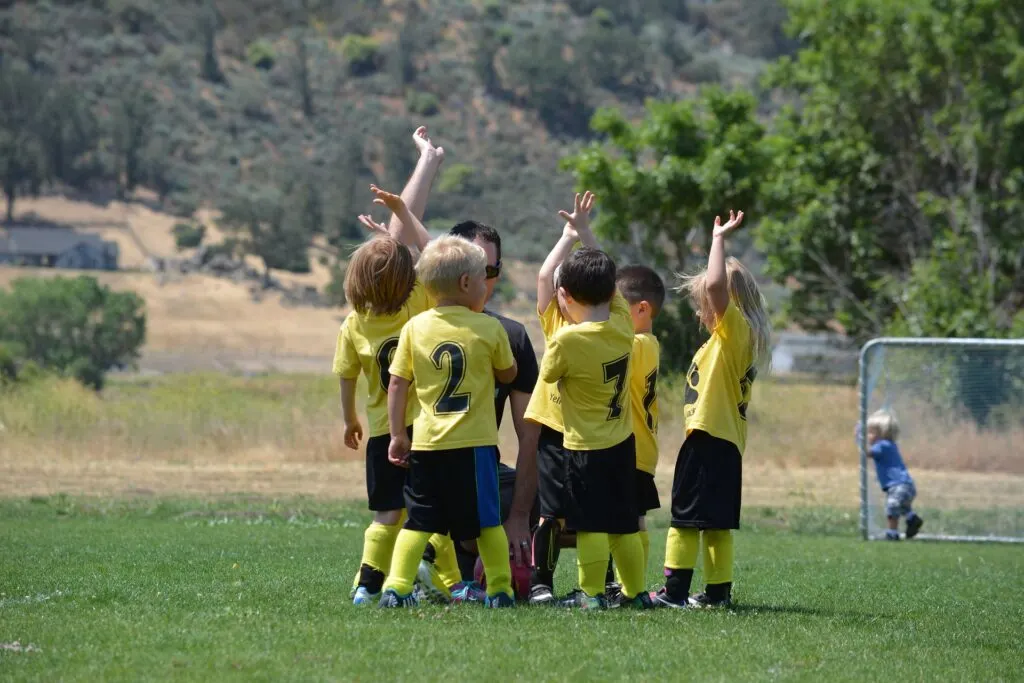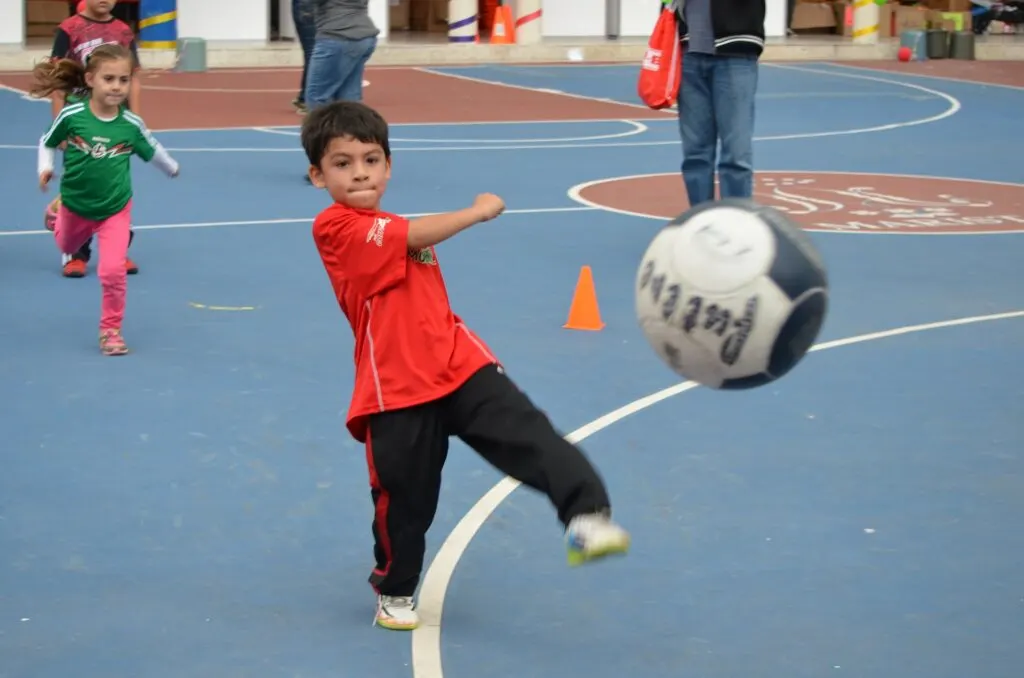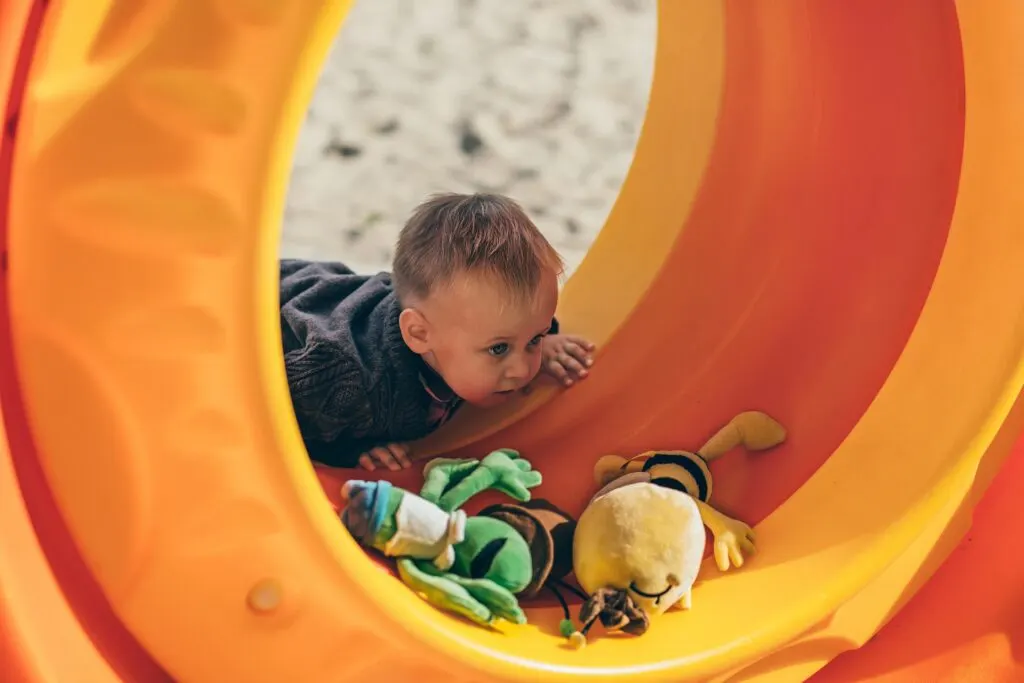Are Toddlers Too Young to Play Soccer?
The simple answer is … yes! A soccer match involves a massive amount of skills, most of which toddlers are far too young to grasp. However, you can train them through early soccer drills for toddler.
At this young age, toddlers don’t have any perception of direction, so trying to get a group of toddlers to play in teams, kicking the ball in opposite directions to one another, is way beyond their realm of understanding.
However, read on for lots of suggestions to work towards early soccer drills for toddler:
Toddlers have only newly learned to walk and then run, and they are still refining these skills, so most toddlers are still a little clumsy.
Kicking is a skill that requires a lot of coordination and balance, so it’s too much to ask to expect toddlers to be able to kick a ball back and forth to one another. However, toddlers can participate in soccer’s pre-skills in many ways.
Having fun as they keep active is the best way to develop our little future soccer stars. Toddlers need time, and they need to play.
For more information on developing physical skills in the Early Years, visit:
How Can I Pass My Love of Soccer Onto My Child?

Introducing new skills, going at your child’s pace, having plenty of giggles and fun, and following your child’s lead is the best way to get toddlers excited about the “beautiful game.”
The soccer drills for toddler won’t look like those we use for junior or senior-age children.
That is because toddlers need a lot more exploratory play before they are anywhere near ready to start following the rules of a soccer game or any other ball game. We should consider replacing the word drill with the word play for this age group.
Follow the simple steps below to encourage your toddler to be active. Regularly active Toddlers are more confident, independent, healthier, and happier.
Don’t worry about the finer details yet. Instead, concentrate on putting in the foundations.
1. Running
Toddlers are new to running, and depending on their stage of development, they usually run in a straight line and crash into whatever is in their way to stop themselves.
Around the age of two years, they start to become aware of obstacles in their path and begin to start running around them.
A few months later, they may start to pick up speed as they run, so we need to be super aware of this, as if unchecked, they can bolt. This is because they haven’t yet grasped object permanence, so they don’t realize you can no longer see them if they run off.
This is when parents often say they “need eyes in the back of their head!”
Toddlers haven’t yet grown into the same proportions that adults have. Their head is larger and heavier on their little body, and their legs aren’t as long as an adult about the length of their torso.
This means their legs simply can’t lift off the ground to stride like an older child or an adult, and they can look clumsy (but very cute).
How can I help my toddler to run?
- Toddlers just need time to practice – Sometimes, you only need to provide space and encouragement when implementing soccer drills for toddler.
- To help develop your toddler’s confidence in running, try using push-along toys such as wheelbarrows, prams, and push-along trolleys.
- When they become confident at pushing, try to pull along toys, for example, a toy dog on a lead or a balloon on a string.
- When they reach their destination, they give lots of praise and encouragement. Try using motivators like a bell ringing to encourage them to run from one point to another.
- Use chase games and make sure there is lots of laughter.
- Outdoors encourage them to chase butterflies or insects and autumn leaves as they fall or bubbles.
- Being outdoors can mean more opportunities to run across different surfaces, and this can also develop confidence and independence.
- If you have them, show your toddler how to run up banks, slopes, or earth mounds to develop those little leg muscles and core strength.
Jumping
Once your toddler is running with more confidence, you may notice that they start to try and jump. Typically this may start to happen around eighteen months, but this is just a guide.
Some children start to jump earlier, and other’s later, but your toddler will do it when they are ready and not before. They will leave the ground with one foot first, and when their muscles are ready, they will manage to jump with two feet together.
Leaving the ground with two feet is much more challenging and may happen later. Incidentally, being able to jump with two feet can indicate that your toddler is ready to start toilet training as they have started to develop more control over the muscles needed.
You may be asking yourself why jumping is a foundation skill for playing soccer. Jumping helps to develop the muscles in your toddler’s legs. It also helps with balance and is a good foundation for little soccer stars to build on.
Think of a soccer match – the goalkeeper constantly jumps in the air, and the players must be nimble on their feet and have good coordination and balance to tackle each other.
However, you should expect a few tumbles before your toddler can run or jump.
How can I help my toddler to jump?
- Introduce games like Simon Says to practice big jumps and little jumps.
- Stepping stones are a great way to practice jumping from one place to another. You can purchase circular discs from most teaching catalogs or use log circles. You must hold their hand to jump until they can do it themselves. Use this opportunity to say one, two, three, and jump!
- Move onto balance benches if you feel ready, but they will probably still need adult support.
- You may need a risk-benefit assessment to ensure your toddlers are safe. Still, please remember to consider all the positive benefits of taking safe risks and becoming physically active.
- Introduce animal pictures or stories to your toddler and jump around like a frog, rabbit, or kangaroo.
- Use pop-up books or toys like a Jack in the Box to encourage jumping up in the air with excitement.
- Show your toddler how to squat down low and lift your arms as you both jump together, saying, ‘Blast off.’
- If you think they are ready, supervise them to use small trampolines and body bounce boards.
As their jumping improves, encourage your toddler to try jumping with their hands on their hips, as this can help them develop even better balance.
Kicking

Kicking is a foundation skill for soccer players, but there is a lot to master here for toddlers. Luckily, most toddlers love to play with a ball. It’s fascinating to them.
Remember that they are still processing new concepts, such as gravity, so throwing a ball into the air and watching it fall again is thrilling.
We take so much for granted as adults, but there is awe and wonder everywhere when you are a toddler.
How can I help my toddler to kick a ball?
- Give lots of free play with lots of different-sized balls during soccer drills for toddler. Your toddler will also learn about angles and trajectory when kicking and throwing the balls.
- Encourage them to kick by swinging their arm back and kicking the opposite foot, which can help their balance.
- If they can’t coordinate themselves yet and miss the ball, there is no need to worry. They just need time to practice with no pressure.
- Your toddler may take a while to realize they can move the ball by kicking it. Sometimes this happens accidentally, but they will want to repeat it when they realize their foot is moving the ball.
- Give lots of happy cheers and praise when they coordinate their body to kick. It’s a big deal when you are that small.
- Toddlers learn from one another, so playing in a group or with a friend is a great way to encourage them.
- At home, you may want to draw their attention to footballers on TV – talk about kicking, heading, jumping, catching, running and rolling, and scoring a goal, of course! If you are excited about the soccer game, the chances are that your toddler will start to feel the same.
- Sometimes, toddlers kick and hit out for the wrong reasons, so it’s important to try and find out why those behaviors are happening and set clear boundaries.
Stopping
Stopping is easier said than done when you are a toddler, and it takes practice. Some toddlers may respond better to seeing a visual symbol that tells them to stop at first than hearing your voice.
I always like to give a warning that the physical playtime is about to end so that playtime doesn’t end too abruptly and leaves your toddler upset or inconsolable.
How can I help my toddler learn to stop?
- Sand timers can be useful for your toddler to see the time left running out.
- Model how to stop and freeze. You can make this into a little game.
- Use traffic light circles. Red to stop and green to go. Keep it very simple and use one-word commands.
- When toddlers learn to run and stop, they’ll have a few tumbles. Try to minimize the drama, dust them down, and encourage them to have another go immediately.
Climbing, crawling, and rolling

Yes … I know you don’t see soccer players climbing, crawling, or rolling on the professional pitch (at least, not that often). Still, when you are a toddler, climbing is important to develop your muscles, core strength, and coordination.
Many toddlers have an inbuilt desire to scale furniture and anything else possible to climb.
They need to climb but remind them that tables, worktops, windowsills, and bookcases are off limits and instead try to provide safe opportunities to use their body strength to climb up and down regularly.
Climbing develops all the core muscles and strengthens the arms and legs, something all great soccer players have, but toddlers need to practice this skill in a safe environment where adults support them.
We often don’t give enough attention to crawling and rolling. They are a key part of a child’s development, as crawling and rolling help develop spatial and directional awareness.
They also contribute to good balance, hand and foot coordination, and agility.
How can I help my toddler to climb, crawl and roll?
- Encourage your child to move their whole body using indoor climbing frames and slides during soccer drills for toddler.
- Use large loose parts play to encourage all of the above. Use large tires, planks, tarpaulins, milk crates, or big cardboard boxes to create dens your toddler can crawl inside.
- Indoor Jungle Jims or ball pools can help enhance your child’s physical development if you can visit.
- Holding your toddlers’ hands to go up and down steps will also help them develop their leg and core muscles. Count out loud as you step up or down together.
- Tunnels are good fun and an excellent way to increase your toddler’s core strength; most toddlers love them. If you haven’t got a tunnel, there is no need to worry – you can easily make one by improvising behind the sofa or crawling under a table with a blanket over it.
Want to know more about helping your child to be physically literate? The webpage below is a really good place to start:
All of the above ideas will help encourage your toddler to be active, healthy, and happy, which are the key components to becoming a successful athlete later in life.
As always with little ones, the most important thing to remember is to have fun and more fun.
